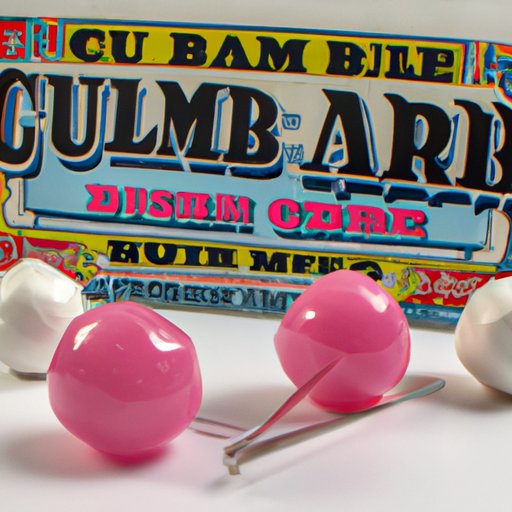Introduction
Bubble gum is a beloved treat enjoyed around the world by children and adults alike. Its signature sweet flavor and ability to blow bubbles make it an iconic part of pop culture. But have you ever wondered how bubble gum was invented? This article will explore the historical timeline of bubble gum’s invention and its impact on popular culture.
A Historical Timeline of Bubble Gum’s Invention
Although bubble gum has been part of our lives for decades, its invention did not happen overnight. Here is a look at the important events in bubble gum’s history:
Pre-1900s: Early Forms of Chewing Gum
Chewing gum has been around since ancient times. The Mayans chewed chicle, a natural gum made from sapodilla trees, and Native Americans chewed spruce tree resin. In the late 1800s, American entrepreneurs began mass-producing chewing gum using synthetic ingredients like paraffin wax and latex.
1928: Walter Diemer’s Invention of Bubble Gum
Walter Diemer, an accountant for the Fleer Chewing Gum Company in Philadelphia, is credited with inventing bubble gum. He experimented with recipes for a type of gum that was softer and easier to chew than traditional chewing gum. After months of experimentation, he finally created a recipe for bubble gum that could be stretched and blown into bubbles.
1930s: The Rise of Bubble Gum in Popular Culture
Once Diemer had perfected his recipe for bubble gum, it quickly became a hit with children. By the 1930s, bubble gum had become a staple of childhood, with companies selling different flavors and colors of bubble gum. It also started appearing in movies and television shows, cementing its place in pop culture.
The Inventor Behind the Invention of Bubble Gum
So who exactly was the genius behind bubble gum’s invention? Here is a closer look at Walter Diemer and his motivations for creating bubble gum.
Who is Walter Diemer?
Walter Diemer was born in 1904 in Philadelphia. He worked as an accountant for the Fleer Chewing Gum Company and was known for his creative spirit and love of experimenting with recipes. In 1928, Diemer set out to create a softer, more pliable form of chewing gum, which eventually led to the invention of bubble gum.
What Inspired Him to Create Bubble Gum?
Diemer was inspired to create bubble gum after noticing that children were having trouble blowing bubbles with traditional chewing gum. He wanted to create a type of gum that was softer and easier to blow bubbles with. After months of experimentation, he developed a recipe for bubble gum that could be stretched and blown into bubbles.

The Science Behind Bubble Gum
Bubble gum is more than just a sugary treat; it is a complex combination of ingredients that work together to create the perfect bubble-blowing experience. Here is a look at the science behind bubble gum.
Ingredients Used to Make Bubble Gum
Bubble gum is made up of several ingredients, including sugar, corn syrup, flavoring, coloring, and gum base. Gum base is a combination of ingredients like resins, vegetable oils, and waxes that give bubble gum its stretchy texture.
Chemical Reactions that Create Bubbles
When bubble gum is chewed, the ingredients mix together and produce a reaction that creates carbon dioxide. This carbon dioxide is released in the form of tiny bubbles, which can then be blown into larger bubbles.

How Bubble Gum Impacted Pop Culture
Bubble gum has been a part of popular culture for decades, with its presence in movies, television shows, and even music. Here is a look at how bubble gum has become a symbol of fun and playfulness.
Bubble Gum as a Symbol of Fun and Playfulness
Bubble gum has become a universal symbol of fun and playfulness. It is often used in movies and television shows to illustrate childhood innocence or whimsical moments. Bubble gum has also been featured in songs like “Bubblegum” by Katy Perry and “Bubblegum Bitch” by Marina and the Diamonds.
Bubble Gum as a Means of Social Expression
In addition to being a symbol of fun and playfulness, bubble gum has also been used as a means of social expression. In the 1950s, bubble gum cards featuring famous athletes and celebrities became popular, allowing people to collect and trade cards with their friends. Bubble gum has also been used as a way to express support for causes and political candidates.

A History of Bubble Gum Flavors
Bubble gum has come a long way since its invention in the 1920s. Today, there are dozens of different flavors of bubble gum available, ranging from classic favorites to more unconventional flavors.
Classic Bubble Gum Flavors
Some of the most popular bubble gum flavors include strawberry, watermelon, grape, and cherry. These classic flavors have remained popular for decades and continue to be some of the most popular bubble gum flavors.
Creative and Unconventional Bubble Gum Flavors
In recent years, bubble gum manufacturers have begun to experiment with more creative and unconventional flavors, such as cotton candy, cola, and even bacon. These unique flavors have helped to keep bubble gum interesting and appealing to a new generation of bubble gum lovers.
Conclusion
Bubble gum has come a long way since its invention in the 1920s. Thanks to the creativity and ingenuity of Walter Diemer, we now have a beloved treat that is enjoyed by people of all ages. Bubble gum has become a symbol of fun and playfulness and has been used as a means of social expression. From classic flavors to more creative ones, bubble gum continues to delight and surprise us.
(Note: Is this article not meeting your expectations? Do you have knowledge or insights to share? Unlock new opportunities and expand your reach by joining our authors team. Click Registration to join us and share your expertise with our readers.)
